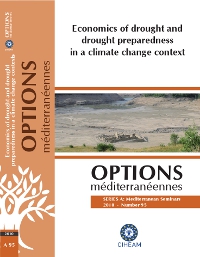| Article précédent | p. 27-33 | Article suivant |
Trends and periodicities in the annual amount of dry days over Argentina, looking towards the climatic change
During the second half of the twentieth century, Southeastern South America experienced a positive trend in annual precipitation. Since Argentina is a country whose economy mostly relies on rain-fed agriculture, this trend has favoured the extension of the agricultural frontier, increasing the availability of productive lands. However, this precipitation increase was accompanied by greater interannual variability in precipitation, which increases the risk of droughts and their consequent negative impacts. In this work we analyze the temporal variability of the annual amounts of dry days (days without rainfall) over Argentina. We found significant trends in several regions of the country that reflects the increments in precipitation amounts. To analyze the interdecadal variability of dry days, we apply the wavelets analysis to the longest time series available, some of them from the beginning of the 20th century. This analysis identifies significant nonstationary periodicities between 8 and 16 years, mainly in the stations of the eastern region.
Durant la seconde partie du vingtième siècle, le sud-est de l'Amérique du Sud a connu une tendance positive des précipitations annuelles. L'Argentine est un pays dont l'économie dépend majoritairement de l'agriculture, tributaire des précipitations, c'est pourquoi cette tendance a favorisé l'extension des frontières agricoles, augmentant ainsi la disponibilité des terres productives. Cependant, cette augmentation des précipitations a été accompagnée d'une variabilité interannuelle plus forte, ce qui a également augmenté les risques de sécheresse et leurs impacts négatifs conséquents. Dans cette étude, nous avons analysé la variabilité temporelle de la quantité annuelle de jours secs (c'est-à-dire les jours sans pluie) en Argentine. Des tendances significatives reflétant l'augmentation des précipitations ont été observées dans certaines régions du pays. Pour analyser la variabilité interdécennale des jours secs, nous avons utilisé l'analyse en ondelettes durant les plus longues séries de temps disponibles, certaines commençant au début du vingtième siècle. Cette analyse a alors permis d'identifier des périodicités non stationnaires significatives entre 8 et 16 ans, principalement dans les stations situées à l'Est de la région étudiée.
- [ Afficher ]
- [ Télécharger ]
- [ Exporter la citation ]
Vous pouvez télécharger la citation au format :
- [ Imprimer ]
-
Mots-clés
ARGENTINE, CHANGEMENT CLIMATIQUE, DONNEE CLIMATIQUE, DONNEE STATISTIQUE, PERIODICITE, SECHERESSECiter cet article
Penalba O., Rivera J., Bettolli M.L. Trends and periodicities in the annual amount of dry days over Argentina, looking towards the climatic change. In : López-Francos A. (comp.), López-Francos A. (collab.). Economics of drought and drought preparedness in a climate change context. Zaragoza : CIHEAM / FAO / ICARDA / GDAR / CEIGRAM / MARM, 2010. p. 27-33. (Options Méditerranéennes : Série A. Séminaires Méditerranéens; n. 95). 2. International Conference on Drought Management, 2010/03/04-06, Istanbul (Turkey). http://om.ciheam.org/om/pdf/a95/00801321.pdf



